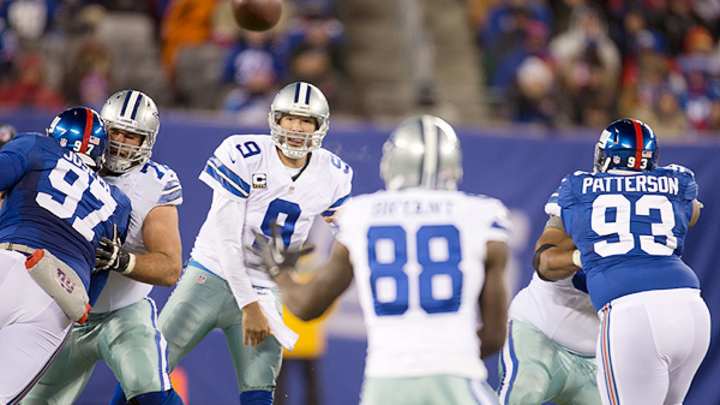The key to efficient offense? Not tempo

The Cowboys were one of the NFL's most efficient offenses in 2013 despite running the fewest plays. (Simon Bruty for SI)
The unofficial motto of most NFL offensive coordinators these days has become, to steal a Jurassic Park line from Jeff Goldblum: Must go faster.
"As this game gets faster and sped up, guys are going to have to prepare the right way," said Bengals offensive lineman Andrew Whitworth last week, discussing the plan by new offensive coordinator Hue Jackson to push the envelope this season when Cincinnati has the football. "To play that style, you have to prepare yourself."
The chorus has been much the same in places like Buffalo, Detroit, Washington and Miami, where the goal is to hit the ground running -- and passing -- in the regular season.
"I’ve never seen anything this fast," Dolphins cornerback Cortland Finnegan said of his team's new offense, via the Sun-Sentinel. "It’s great. It’s going to be great for us as an offense and defense."
MORE COVERAGE: Offseason Report Cards | NFL Power Rankings | 2015 NFL Mock Draft
Does it all matter, though? Denver's fast-paced attack set a scoring standard last season, and Chip Kelly's scheme left many a defensive coordinator grasping at straws in 2013. But tempo only takes a team so far. In fact, the stats from last season show that buzzword is of secondary importance to another critical concept: offensive efficiency.
It was a team's ability to score at a consistent clip, not necessarily how rapid its possessions progressed, that stood as a harbinger of success last season. Of the teams that ranked in the top 15 in points per play last season, 12 made the playoffs.
Before we go any further, a look at that points-per-play mark for all 32 teams, calculated by dividing points scored (with defensive and special-teams TDs removed) by offensive snaps.
Not surprisingly, the Broncos lapped the field. Seeing the Eagles land at No. 3 in this particular ranking comes as no shock, either.
What occurred between those squads is unexpected, however, with Dallas landing second overall with a .415 points-per-play average. The Cowboys' landing spot highlights two truths: 1. Generating more snaps may not be necessary to produce points -- they ran just 957 offensive plays last season, least of any team in the league; 2. That scoring at an efficient rate matters little if a team's defense cannot keep up.
Dallas finished the year having allowed the NFL's most yards (6,645) and the seventh-most points (432). Its opposition snapped the ball 1,094 times on offense, about 14 percent more than did Tony Romo and Co. The Cowboys' big-play ability merely helped them break even rather than setting them apart like Denver.
Also of note are the teams two and four spots back of Dallas, respectively, in the efficiency rankings: Seattle and San Francisco. Like Dallas, neither of those teams made it to the 1,000-play plateau. Their production came out of far less desperation, however, as the Seahawks finished No. 1 in points allowed and the 49ers No. 3. The NFC West rivals also produced a combined 69 turnovers on defense, meaning shorter fields and less pressure for their offenses.
On the flip side are teams like Buffalo and Washington, whose offenses spun their wheels en route to more than 1,110 plays each last season, unable to produce enough points to offset porous defenses. While Dallas' stats point to a potential problem with scoring too quickly -- namely, putting an underperforming defense on the field often -- the Bills and Redskins of the world make clear that simply snapping the football a great deal does little to guarantee points.
So how does a team move from the bottom of the barrel in efficiency toward the top? A variety of factors impact the outcome: defensive performance, quarterback play, turnover margin, etc. Pace of play only becomes a critical aspect of an offense's production if it can control the chaos.
This is, at least over the second half of the 2013 season, what Philadelphia managed to accomplish.
"There’s a lot of variety," Saints coach Sean Payton said before his team knocked off the Eagles in the playoffs, 26-24. "You have to defend the whole field. ... They do a great job with misdirection and a great job with creating those running lanes and really keeping you off balance defensively.
"It’s hard to prepare for, it’s hard to simulate in practice with the scout team. The pace is extremely fast, extremely fast. So we’ll have our work cut out for us this week with just trying to replicate or give the same look from our scout team offense."
This is what teams are hoping for when they envision a quicker offensive pace. If such an approach is executed properly, it can leave defenses confused and fatigued, thereby leading the way to those home-run plays that Denver, Philadelphia, New Orleans and others atop the efficiency rankings created.
The question here: Which of the teams from the bottom half of the above rankings could rise in 2014? Detroit, which sat at No. 17 overall, has the weapons to produce more reliably. Atlanta, if Julio Jones and Roddy White are healthy, is a candidate as well. And the Redskins of 2012 operated at a .396 efficiency, which would have been good for a top-five ranking last season. That output bodes well for them in 2014, if Robert Griffin III can regain his rookie-year form, as well as for the Cleveland Browns now that ex-Washington play-caller Kyle Shanahan is on staff.
There is no real certainty here, however, shy of acquiring Peyton Manning or Tom Brady -- two quarterbacks at or near the top of the points-per-play list annually.

Chris Burke covers the NFL for Sports Illustrated and is SI.com’s lead NFL draft expert. He joined SI in 2011 and lives in Ann Arbor, Mich.